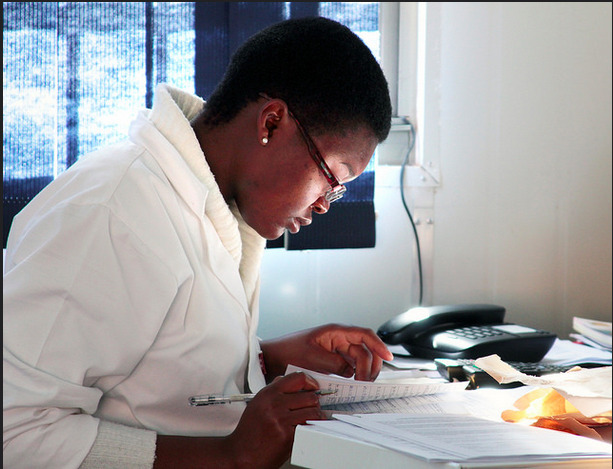One life changed
Lerato, 30, sits in a counseling room at Senkatana, Lesotho’s largest HIV/AIDS care and treatment center, located in the capital city of Maseru. Lerato, who is HIV-positive, heard about Senkatana’s cervical cancer prevention program on the radio and decided to come in for screening. A precancerous lesion was discovered during her screening; she is about to have the lesion removed.
“I had a friend who died from [cervical] cancer,” Lerato says. “As she was ill, I saw that it was a terrible disease. I didn’t want to reach that point.”
Two years ago, cervical cancer was a death sentence for women in Lesotho. Although cervical cancer is the leading cause of death among women in the country, pap smears (used to identify cancer cells on the cervix) were inaccessible to much of the population. For those lucky enough to receive a pap smear, accessing the results was another challenge. Laboratories to process these diagnostics are scarce and overburdened. It would take weeks or months for the results of a pap smear to be processed and delivered.
The human papilloma virus (HPV)—an extremely common sexually transmitted infection that causes cervical cancer— replicates easily in women with compromised immune systems, making HIV-positive women four to five times more likely than HIV-negative women to develop invasive cervical cancer.
The Senkatana Centre, an Elizabeth Glaser Pediatric AIDS Foundation-supported site, houses Lesotho’s first cervical cancer screening program. Prior to the development of this center, women in Lesotho diagnosed with cervical cancer would be transferred to a hospital in in neighboring South Africa for treatment.
Senkatana uses visual inspection with acetic acid (VIA) to screen a woman’s cervix for precancerous lesions. In contrast to a pap smear, in which a doctor or nurse takes a sample of cells from a woman’s cervix and sends off for screening, VIA yields a visual diagnosis within minutes. VIA also costs only a few cents, compared to $10-$15 per pap smear. When using VIA, a health worker applies white vinegar to the woman’s cervix and visually scans the cervix for abnormalities. If the woman is infected with HPV and has a precancerous lesion, the lesion appears white when it comes into contact with vinegar. In the time it takes to apply vinegar and visually inspect the cervix, the health care worker can accurately diagnosis a precancerous cervical lesion.
Lerato explains that she arrived at Senkatana’s cervical cancer center, located in a building adjacent to the HIV and tuberculosis treatment centers, and received a warm welcome from the staff. “There was somebody who was teaching about HPV. That allayed my anxiety. I went into the consulting room for screening and I was relaxed.”
At Senkatana, women diagnosed with precancerous lesions through VIA can have the lesions removed immediately after their screenings. “We offer [treatment] there and then, if the patient finds it comfortable,” says Nurse Mantsane Sole, EGPAF’s prevention of mother-to child HIV transmission and reproductive health officer based at Senkatana. “Ninety-nine percent of our [VIA] clients are treated immediately.” The center offers cryotherapy and loop electrosurgical excision procedures to treat lesions.
The Program
EGPAF founded the National Cervical Cancer Prevention Program in January 2013 with financial support from USAID and in partnership with Lesotho’s Ministry of Health. Getting the program off the ground wasn’t easy, but with these three organizations working together, the EGPAF project gained the momentum it needed to take off. In the two years since Senkatana activities launched, EGPAF has screened more than 4,200 women, treated 350 for pre-cancerous lesions, diagnosed and referred 88 with early invasive cancer.
“Of women visiting the center with precancerous lesions, and all of them received treatment. Every single one of them who came to the center was treated at the center,” says Appolinaire Tiam, EGPAF’s country director. “This is the most positive outcome.”
EGPAF’s support of the Senkatana treatment center is funded through the U.S. Agency for International Development (USAID).
For more information about Senkatana, read the Life Story segment.
To watch a video about Senkatana, click here.
To read more about EGPAF-Lesotho’s program, click here.




